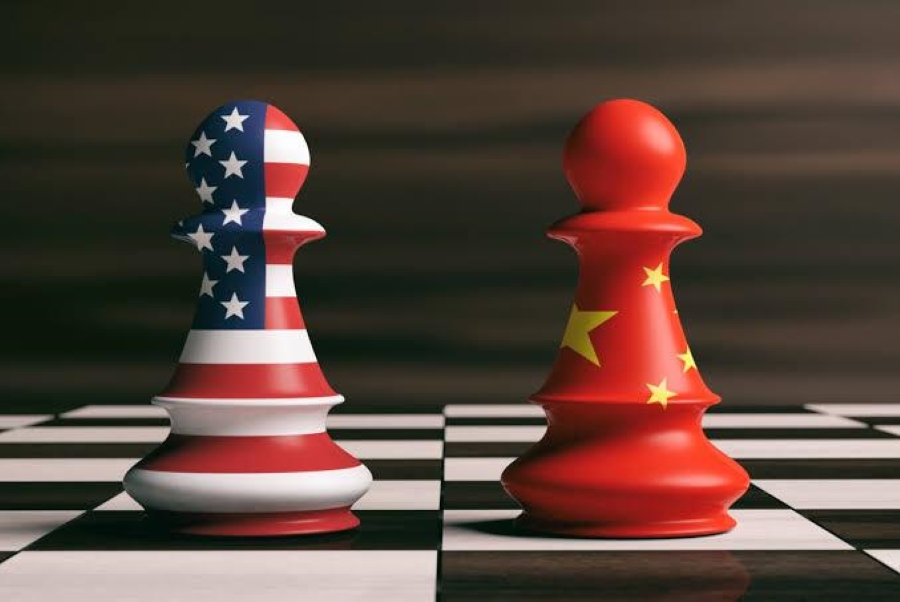The global order is undergoing a gargantuan transition, and the US-China bickering is shambolically shaping the new world order. Countries and regions are in flux, geo-political and geo-economic competition is exacerbating, and to top it all, the transnational threat posed by the novel coronavirus is challenging to alter the definition of national security.
Amidst this incorrigible US-China power tussle and changed geostrategic environment, a shift in the global order is imperative. This raises a question as to how far Beijing will continue to push the envelope in its quest of becoming an indomitable global power and where new global order is heading for?
Unlike the past four decades of Cold War bipolar confrontations between the US and USSR, the current international order represents the far more diffused world order. Nevertheless, in the words of APJ Taylor, “history has refused to turn,” and the ghost of polarisation is once again haunting the international system.
At the nub of this new global (dis)order is the US-China great power dynamics. The US-China fragmentary ties and discordant power rivalry that have subsisted for long is lividly altering the world order. The current cold confrontation between the US and China, unlike the Cold War confrontation though, discerns the cold blast of the ideological divide. Still, it underlines the contestations between the security and economic prowess of two giant powers as new faultiness.
Mapping and Cracking the US-China Squabble
It was not until the outbreak of the Korean War in 1950 that the US decided to directly confront Beijing or the Chinese Communist Party (CCP). During the Chinese Civil War (1945-49), Dean Acheson, the then US Secretary of State, stated that the US commitment towards Asia should only be ‘symbolic’ and thus adopted “hands-off” policy towards Republic of China (ROC or Taiwan) to refrain from interfering in internal matters of China. For nearly three decades, from 1950-1979, the US-China witnessed only secondary relations to US-Taiwan relations.
The Sino-Soviet tensions paved the way for US-China rapprochement by cutting all diplomatic ties with Taiwan through the formulation of ‘One-China’ policy by the Nixon administration in 1972 (Shanghai Communiqué, 1972) and normalization of US-China ties in 1979 (Joint Communiqué on the Establishment of Diplomatic Relations, 1979) under the Carter administration. Since 1979, Washington shares robust unofficial relations with Taipei through the landmark legislation called ‘Taiwan Relations Act’ of 1979.
The current US-China bilateral relation is undergoing profound changes, then that existed in the 1970s-80s. The complex interplay of US-China power dynamics has eschewed structural forces of globalization, slumped global economy, portended multilateralism, and accentuated volatility in different regions. The precipitous decline in US-China ties is unravelling at a time when the world is reeling under the heels of grim global economic slowdown and facing the portentous point in the tumultuous history due to the outbreak of Covid-19.
Under Trump administration, particularly since the second term of the Obama administration, Sino-American relations have suffered a real setback. The US foreign policy demarches, under Trump administration aims to highlight Chinese megalomaniac and potentate behaviour by calling it as a “strategic competitor” and a “revisionist power” in its National Security Strategy (NSS) report, 2017. In keeping with the trade dispute or expansion of military capabilities, both the countries remain at loggerheads. Moreover, the outbreak of Covid-19 in Wuhan and shoddy handling of the crisis by the Chinese government, have further pushed the US-China relations down a slippery slope.
The judder in bilateral relations came at a time when both the countries should have acted in a concerted manner to fight against the pandemic and work together for a viable and stable health system to achieve a medical breakthrough. However, what the entire world witnessed was a callous and lackadaisical behaviour on the part of both the countries.
Beijing’s Cynical Power Game
China, as an imperious and irredentist state, has managed to hoodwink the world and, to some extent, Americans under the nomenclature of its ‘peaceful rise’. However, the Chinese actions across the world juxtapose US putative claim of Beijing being a ‘responsible global stakeholder’ or its proclivity of ‘peaceful-rise’. Beijing’s grander strategic design, emboldened by its ‘Chinese dream’ unequivocally reiterates Peoples Republic of China (PRC) ambition to become an insurmountable global power. It tries to obfuscate the reality of its cynical power game by flouting international laws and through its startling economic projects.
Chinese tactics of using financial tools of debt-trap diplomacy in the form of major infrastructure initiatives like Belt and Road Initiative (BRI) in countries such as Pakistan, Sri Lanka, Maldives, Myanmar etc. or creating parallel international economic institutions like Asian Infrastructure Investment Bank (AIIB), New Development Bank (NDB) etc. are seen as a direct threat to US-led liberal world order.
Its repugnant military actions to encroach, grab and unilaterally alter the status quo are also not new. Recently, the similar modus operandi was witnessed in Galwan valley that resulted in the killing of twenty Indian soldiers. Countries are getting increasingly wary of Beijing’s accentuating muscle-flexing in the South China Sea, its intrusion in the East China Sea, bullying small neighbours, ossifying foothold in Indo-Pacific, fatuously claiming and grabbing the unsettled boundary with India, altering the status-quo across the Taiwan Strait, practising economic coercion and targeted cyber-attacks in Australia, renaming vessels in Vietnam, and unveiling national security law criminalizing acts of subversion, secession and terrorism in Hong Kong.
The above acts of Chinese belligerence allude to the fact that they are no aberrations. Xi’s accentuating imperiousness, coupled with its policies based on medieval mind-set, indicates that Chinese aggressive actions are in a way part of building the ‘Xi dynasty’ and achieving the ‘Chinese Dream’. As part of constructing this ‘Xi dynasty’, PRC perceives America at the global stage and India in the Asian region as a major irritant and a stumbling block.
Asia Conundrum
Many analysts have argued that the confrontation between two giant powers will be fundamental to Asian order rejig. The contestation between China’s economic prowess vis-à-vis United States security aspects will tend to push countries on either side of the economic or security faultlines. On a number of occasions, China has tried to expose these faultlines by exploiting the divergence between the USA and other democratic nations to undermine the American dominance in the region.
China might have emerged as the uncontested leader in Asia, but it is incumbent on the countries to pushback against Beijing’s grander strategic design. Many countries find themselves under tremendous pressure to stand against Beijing as it involves high economic stakes and costs for nations. However, the mishandling of the COVID-19 crisis and intensification of China’s assertive behaviour of pre-pandemic trajectory has pushed countries like the UK, US, Australia, Japan, South Korea, Vietnam, Taiwan to unite to protect rule-based international order and shared democratic values.
For examples, the formation of “Inter-Parliamentary Alliance on China” of eight democratic countries was formed on June 5 to take a proactive approach on issues related to Beijing; UK has also seemed to build new 5G Club of “D10” by expanding the G7 and including three other democratic countries namely Australia, India, and South Korea as an alternative supplier to meet the requirements of 5G equipment to reduce their economic dependence on China; Quadrilateral Security Initiative (QUAD), though not an “Asian NATO” but its upgradation from official to the ministerial level indicates that countries are ready to shed their reticence against China in the Indo-Pacific.
The Prospects of New World Order
Albeit, Covid-19 outbreak has addled things, but Beijing’s blatant aggressiveness is impossible to ignore. Many countries national security is reeling under constant threat because of Beijing’s excessive economic and strategic indulgence. Moreover, the American position has been continuously under the scanner, especially under President Trump leadership who gets completely flummoxed when any novel problem arises. Such scenarios only hint at the precarious state of international order.
It has also been argued that the Galwan incident will push India towards permissive balancing with the US and other regional powers in Asia. Unlike China’s pernicious economic policies apropos trade and connectivity, India’s foreign policy in Asia is largely driven by its strategic concerns. Hence, it would be interesting to see whether New Delhi and Beijing can find a modus vivendi, similar to the pre-Galwan trajectory.
It is pertinent to understand, countries around the globe may have unique vulnerabilities and strengths, but a common enemy always unites them. Therefore, the Chinese actions that have time and again raised hackles require actions based on hard-nosed realism. Succinctly put, the countries should no longer remain smitten to Beijing’s economic heft or kowtow to its political intimidation. A sense of trepidation or capitulation to Chinese scourge will only accentuate Beijing’s brazen and illegal engagements in the near future.
References
National Security Strategy of the United States of America, The White House. December 18, 2017. [Online Web URL]https://www.whitehouse.gov/wp-content/uploads/2017/12/NSS-Fnal-12-18-2017-0905.pdf
Inter-Parliamentary Alliance on China (IPAC) [Online Web URL] https://www.ipac.global/
Fisher, Lucy. “Downing Street plans new 5G club of democracies”, The Times, May 29, 2020. [Online Web URL] https://www.thetimes.co.uk/article/downing-street-plans-new-5g-club-of-democracies-bfnd5wj57
Jaishankar, Pompeo agree on early meeting of Quad, August 9 2020 [Online Web URL] https://www.tribuneindia.com/news/nation/jaishankar-pompeo-agree-on-early-meeting-of-quad-123572


